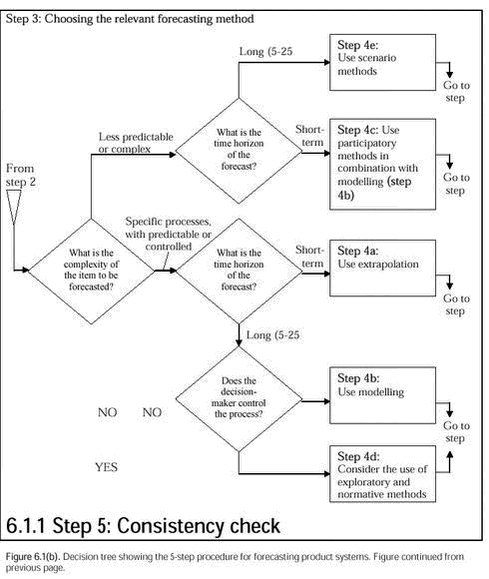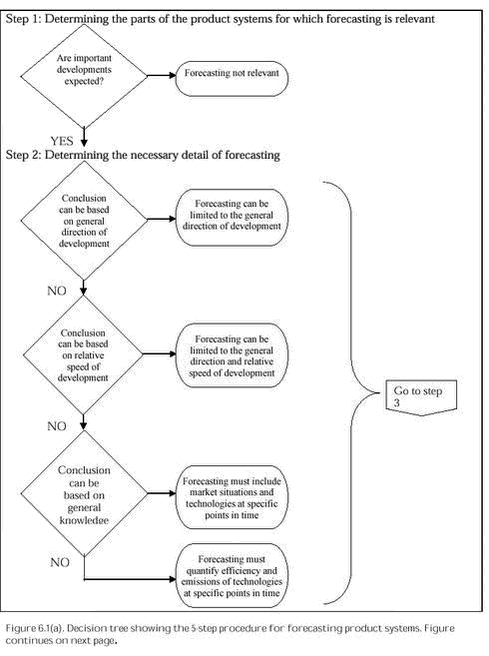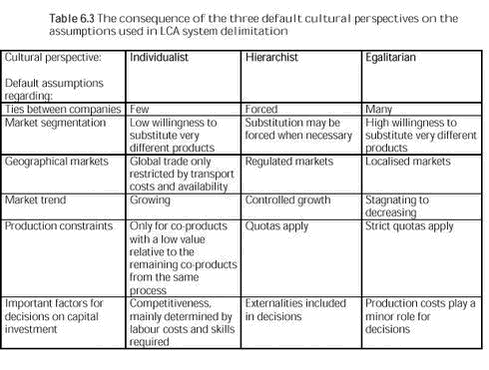Market information in life cycle assessment6 Forecasting future processes6.1 Procedure6.1.1 Step 5: Consistency check 6.2 Determining the parts of the product systems for which forecasting is relevant 6.2.1 Time horizon of study 6.2.2 Position in the life cycle 6.3 Determining the necessary detail of forecasting 6.4 Choosing the relevant forecasting method 6.5 Forecasting by extrapolation 6.6 Forecasting by modelling 6.7 Participatory forecasting 6.8 Exploratory and normative forecasting 6.9 Scenario forecasting 6.10 Consistency check 6.11 Combining different forecasting methods Forecasting is the activity of producing a forecast. A forecast is a statement about the future. Forecasting is done in almost all aspects of life and at a number of different levels. Weather forecasting, forecasting of sales curves and technology forecasting are commonly used. In the previous chapters, reference was made to the time horizon of the studied change, and it was made clear that the processes to include in the studied product systems may change over time, depending on the future market situation. The topic of this chapter is the actual forecasting procedures to be applied. The alternative to forecasting is the use of unjustified assumptions about the future or the use of data for the current situation as proxies for data for the future situation. While this may be adequate in some situations (and especially in the first iteration of a life cycle assessment) and for some parts of the product systems, the use of forecasting is often necessary to ensure adequate validity of the data used and the conclusions drawn. The purpose of this chapter is to show the relevance of forecasting and to recommend a procedure to improve the consistency and transparency of the forecasting. Forecasting product systems includes both:
6.1 ProcedureThe procedure consists of five steps (illustrated in the flowchart in figure 6.1):
6.1.1 Step 5: Consistency check Click on the picture to see the html-version of: Figure 6.1(b) 6.2 Determining the parts of the product systems for which forecasting is relevantIt may not be equally important to forecast all parts of the product systems. There may even be entire life cycle assessments where forecasting is not necessary. The factors that need to be considered are:
Speed of development Radical or untypical developments 6.2.1 Time horizon of studyThe general need for forecasting depends on the relation between the time horizon of the study and the general speed of development, taking into account also any untypical developments. The time horizon of the study is determined by the period for which the conclusions of the life cycle study should be valid plus the life-time of the affected capital investments. This period is typically considerably longer than the lifetime of the product. The period for which the conclusions should be valid is related to the application area of the study (cf. figure 1.1). Forecasting is typically relevant if the time horizon of the study is longer than 5 years. In addition, forecasting is relevant in sectors with rapid development or if radical or untypical developments can be expected. 6.2.2 Position in the life cycleEven when the time horizon of the study is longer than 5 years, not all processes in the life cycle may be affected so far into the future that forecasting becomes relevant. 6.3 Determining the necessary detail of forecastingAs any other aspect of life cycle assessment, forecasting may be made in more or less detail. Covering the most important processes in the studied life cycles, a forecast may include (in order of increasing detail):
If the general direction of development confirms or enhances the current situation, this qualitative information may be adequate as an addition to a life cycle study based on current or historical data. For example, to conclude that an alternative energy source that is currently competitive versus fossil fuels will continue to be competitive, it is adequate to have the general knowledge that costs of fossil fuel resources will be slowly increasing on the long term (as reserves are depleted) and that costs of the alternative energy source will continue to fall (following an ordinary learning curve). The relative speed of development of different processes must be taken into account if the direction of development does not in itself provide a clear indication, and if the speed of development is not uniform for all the involved processes. This information, which is still qualitative, may sometimes be adequate basis for a conclusion. For example, when the price of all fossil fuels are expected to increase in the long run, it is necessary to know the relative speed of price developments for coal, oil, and natural gas, in order to determine which fossil fuel will be the most competitive in the future. Combining knowledge on the direction and speed of development with more quantitative information allows forecasts of the market situation and the technologies involved at specific points in time. For example, information on the current costs of coal and wind power and the actual speed of cost developments for these two technologies (e.g. expressed in average percentage change in raw material costs and efficiency per year and/or as a coefficient of a learning curve) will allow to forecast whether wind power or coal power is the most competitive at a specific point in time. If necessary, the relevant technologies may then be further quantified, also in terms of exchanges, by combining specific technical information with general forecasts on technical efficiency and emission control. An example of a forecast combining knowledge on the direction and speed of development can be found in Prognos (1999). 6.4 Choosing the relevant forecasting methodSeveral methods can be used for forecasting, some of which are more commonly used for specific applications. The most extensive description of methods is by the UN millennium project (Glenn 1994a, 1999). Other reviews of methodology are made by Bell (1997), Donnelly (1997), Vanston (1995), and Martino (1972). The number of described methods varies between the different reviews. Also, terminology is variable and overlaps occur. Strict definitions of the specific methods are generally lacking. The taxonomy suggested by the UN millennium project (Gordon 1994a, 1999) distinguish the methods as either: However, the authors describe themselves the shortcomings of this taxonomy: The normative/exploratory dimension relates more to the application of the methods than to the methods themselves. Many methods are used for both normative and exploratory forecasting. As for the quantitative/qualitative distinction, it is argued that even quantitative methods use qualitative assumptions and a qualitative method can use numbers (Glenn 1994b). Other taxonomies have been suggested by Vanston (1995), dividing according to different views of the future (extrapolators, pattern analysts, goal analysts, counter punchers and intuitors), and Michael Marien (cited in Glenn 1994b) using a division according to 7 P‘s (probable, possible, preferable, present, past, panoramic and participatory). We have found it most useful to divide the methods into 6 groups: - Extrapolation, which we describe shortly below. The forecasting method to apply in a specific situation depends on the time horizon of the forecast and the predictability and complexity of the item to be forecast (see table 6.2). The choice of method does not depend on the required detail.
Extrapolation is based on extending historical and current trends into the future. It is based on a belief that the future represents a logical extension of the past and that information contained in historical data can be extracted, analysed, and reduced to one or more equations that can be used to predict future events. This may be adequate for short-to-medium term forecasts of specific processes, when no radical or untypical developments are expected. A forecast based on extrapolation may also be used as a surprise-free base-line forecast ("suppose things keep going as they have in the past ...") for the modifications of other methods. Trend analysis, time series, regression, econometrics, and simulation modelling belong in this group (Futures Group 1994a).
Modelling seeks to identify the determining mechanisms and to model how the combined effects of several mechanisms will influence the future. It is based on a belief that future events will be influenced by mechanisms analogous to those determining past events. Thus the best way to describe the future is by identifying the determining mechanisms and to model how these will influence the future. In this way, probabilities rather than possibilities are considered. Examples of methods for identifying determining mechanisms and probabilities are analogy analysis, technological sequence analysis, stakeholder analysis (Vanston 1995), and structural analysis. In trend impact analysis, surprise-free forecasts are adjusted to accommodate the expected impact of determining mechanisms (Gordon 1994b). Using cross-impact analysis (Gordon 1994c), probabilistic systems dynamics (Monte Carlo models), engineering-economic models and equilibrium models, the combined effects of several trends can be studied.
Participatory methods seek the insight and opinions of experts and stakeholders. They are based on the belief the future is shaped by complex mixture of trends, random events and actions of individuals and institutions. Therefore, to forecast the future, the insight and opinions of experts and stakeholders are seen as more useful than rational methods. The results of these methods are often more normative (what the future should be) than analytic (what the future is likely to be). However, analytical and modelling methods may provide input to guide participatory methods and the results from participatory methods may be used as inputs in modelling methods. Participatory methods are mainly relevant in complex situations, whereas in simple situations with a high degree of control, stakeholder involvement may be an unnecessary complication. Participatory methods range from the more structured Delphi technique (Gordon 1994d), scanning (Gordon & Glenn 1994), focus groups, charrette, Syncon, and future search conferences (Glenn 1994d) to the less structured methods relying more on subjective judgement, such as genius forecasting, intuition and visioning (Glenn 1994e).
Exploratory methods seek to structure all possible futures by combining analytic techniques, which give an exhaustive qualitative description of the field, with imaginative techniques aimed at filling all gaps in the analytical structure. In this way, possibilities rather than probabilities are considered. This may be useful in product development, for those processes upon which the decision-maker has a large potential influence. Morphological analysis, relevance trees, mind mapping and future wheel belong to this category (Futures Group 1994b, Glenn 1994c).
Normative (or goal-oriented) forecasting begins with stating the desired future and then moves backwards in time to identify the necessary steps for reaching this goal (Coates 1994). Besides this particularity, any of the above mentioned methods might be applied also in normative forecasting. Like exploratory methods, normative forecasting may be useful in product development, for those processes upon which the decision-maker has a large potential influence. Backcasting is an important member of this category.
Scenario methods include and combine aspects of the other methods, especially participatory, modelling and exploratory methods, with the aim of creating several distinct scenarios. They are based on the belief that the future is essentially unpredictable and largely random. Considering the uncertainties, modelling will not lead to one future, but rather to many different futures, each of which may be described in the form of a scenario (Futures Group 1994c). The divisions in table 6.2 should be seen as guiding only. In practice, the distinction between the different situations and relevant methods is not sharp, and more than one method may be relevant in a specific situation. Often, different methods can be combined to give a more reliable forecast (see section 6.2). 6.5 Forecasting by extrapolationExtrapolation is the simple (linear or non-linear) prolongation into the future of historical relations. While all time series of data may be extrapolated, it is not all data that it is meaningful to extrapolate. To improve the reliability:
Some general conclusions from empirical observations may be applied:
Sources of time series may be:
Kakudate et al. (2000) provide an LCA-relevant example of extrapolation of copper contamination of steel based on steel production statistics, the lifetime of steel products, and national recycling, import, and export rates. An extrapolation is not necessarily quantitative, but can be e.g. a text description of the consequences of extending the prevailing trends into the future.
Limitations of extrapolation in forecasting In spite of its limitations, an extrapolation is a better forecast than an assumption of status-quo. Thus, even when there is no time or resources to involve technical experts, it may be justified that a non-expert makes a simple extrapolation as a first approximation. 6.6 Forecasting by modellingModelling is the analysis of the interactions of several cause-effect mechanisms over time, depending on their relative strengths and probabilities of occurrence. Modelling is based on an identification of relevant mechanisms, their probabilities of occurrence, and their interactions. In this way, otherwise surprise-free forecasts are adjusted to accommodate the expected interactions of determining mechanisms. Many of the publicly available forecasts for more complex systems (concerning e.g. electricity production, disposal, collection of waste etc.), as provided by governmental bodies or industry organisations, are based on modelling. Models can be divided in bottom-up engineering-economic models (such as European Commission 1995a, Mattsson 1997, Mattsson & Wene 1997, Stein & Wagner 1999, Kram et al. 2001, Gielen & Moriguchi 2001), and top-down macroeconomic and general equilibrium models such as those used by IEA (2000b). Jochem (1999) delivers a critique of engineering-economic models compared to top-down models and conclude: “Top-down [modelling] communities have far too little knowledge imbedded with regard to technological change, saturation in high income economies, and structural change. Engineering-economic modellers, on the other side, have little to say on the influence of rebound effects or income effects, which may be very important in specific target groups (e.g. private households),” and recommend a better integration of the communities of engineering-economic and top-down modellers. Walter-Jørgensen (1999) presents an interesting combination of technical analysis, farm-level economic analysis and use of a general equilibrium model in a study on phasing out of pesticide use. Complex models as the ones mentioned above, cannot be explained in few words, and we therefore give only a few examples of more domain-specific models and applications:
Example: Modelling the energy use and emissions from
Changes in emissions depend on all of the above plus changes in fuel composition and emission control. The interdependence of the different variables can be expressed in the form of equations, and a time series can be determined for the determining variables. This constitutes a model. Several such models of transport systems exist, e.g. as a result of the EU COST 319 action. The following example shows a very simple, qualitative form of modelling, with only a few variables.
Example (from de Beer 1998): Supplemented by a consideration of costs and benefits (strip casting having the largest potential for energy savings), this modelling leads to placing the most probable future technologies (thin slab casting and strip casting) on a time series.
Limitations of modelling in forecasting Still, depending on the number of variables and the degree of uncertainty included in the modelling, it may result in oversimplification of the future. Thus, in studies that deal with less predictable processes and more complex systems, where the driving forces can work in many directions, modelling should be supplemented by participatory methods (see section 6.1.6), and for forecasts with a longer time horizon, several scenarios should be applied (see section 6.1.8). Modelling will typically require the involvement of technical experts both for the identification of relevant mechanisms, their interactions, and their probabilities of occurrence. It may thus be too sophisticated for more simple situations (medium or short-term forecasts for smaller, specific areas, where no radical or untypical developments are expected). Participatory forecasting methods use the insight and opinions of experts and stakeholders to derive statements on the possibility and/or probability of future events and mechanisms and their interaction. The insight and opinions of experts and stakeholders are derived: These sources may also be used in combination. Scanning of published information is the most neutral of the methods, but its scope is limited to the issues on which published information is available, and it does not allow interaction between the source and the inquirer. When selecting sources or participants for polling, interviews, or panels, more or less weight may be placed on involvement of: All participatory methods have an element of subjectivity, which may be countered in different ways: Forecasts resulting from participatory techniques are quite often available in published form.
Limitations of participatory methods However, because of their subjective elements, participatory methods may still be seen as unacceptable both by those who feel unable to influence the result and by those who see the participatory process as endangering to their established power. Also, participatory methods are quite time consuming and difficult to apply, and will therefore be too sophisticated for more simple situations (medium or short-term forecasts for smaller, specific areas, where no radical or untypical developments are expected). For processes upon which the decision-maker has a large degree of (potential) influence, and especially in the context of product development, it may be more interesting to examine how the future could be (using exploratory methods), or how it should be (using normative methods), than how it is likely to be (using analytical methods, such as modelling). Exploratory methods concentrate on structuring possible futures, typically using qualitative descriptions. Exploratory methods combine analytic techniques that branches a broad topic or development into increasingly smaller subtopics or consequences, and imaginative techniques aimed at filling all gaps in the analytical structure. In this way, the full field of possibilities is identified and structured, providing a multitude of combinations and permutations as a starting point for e.g. product development. This large number of possibilities may afterwards be reduced according to economic, technical, and strategic criteria, summarised as e.g. breakthrough potential and importance to the decision-maker. An example of an exploratory method for use in product development is TRIZ, a commercial method that combines analogy and morphological analysis (Kowalick 1997, Arciszewski & Zlotin 1998). TRIZ is based on systematic analysis of patents from which a number of principles of innovation and "laws of evolution of engineering systems" were derived (Altshuller 1984). Morphological analysis is used to identify the essential functions of the investigated product and the possible solutions for specific functions. These possible solutions are then combined with the innovation principles and the above statements or "laws" to point out the most relevant future solution. In TRIZ, functions and methods have been collected in a database. The TRIZ database is usually used in product development but it can also be used for technological forecasting by simulating the product development. Normative (or goal-oriented) forecasting investigates how we want the future to be and how to obtain this goal. In contrast to e.g. modelling, which investigates possibilities and probabilities and generally moves forward into the future in terms of forces at play, normative forecasting states objectives that may be substantially discontinuous with the trends at play, then moves backwards to the present to identify the necessary steps for reaching the objectives. Besides this particularity, any of the other forecasting methods may be applied also in normative forecasting. Normative forecasting is at the heart of organisational planning. It allows an organisation to orchestrate and target its resources to achieve a goal. The statement of the goal itself must be realistic and take into account present and future resources and contexts. A crucial part of a normative forecast is the detailed analysis, which reveals the specific steps that must be taken at specific times. Exploratory and normative forecasting require a detailed knowledge of the involved organisation and technical field. It must therefore be performed in close co-operation with knowledgeable people in the organisation. The involvement of the decision-makers is essential in the criteria-setting stage of exploratory forecasting and the goal-setting stage of normative forecasting. Technology roadmaps are one result of exploratory normative forecasting. Examples are Eisenhauer et al. (1997), Semiconductor Industry Association (1999).
Limitations of exploratory and normative forecasting For long-term forecasts in complex situations where many interdependent forces are at play, it is unlikely that a specific forecast can be identified as the single “most likely” description of the future. Instead, scenario methods aim at presenting a broad range of plausible outcomes (scenarios), which can serve as a basis for robust conclusions that are viable over the wide range of possible futures. The term “scenario” comes from the dramatic arts, where a scenario refers to an outline of the plot. In forecasting, a scenario is an integrated, coherent, and consistent narrative description of a plausible future situation, often including a description of the development from the present to the future to focus attention on causal processes and decision points. Often scenarios are based on modelling, displaying the conditions of important variables over time, thereby giving a quantitative underpinning of the narrative description. The nature of evolutionary paths are especially relevant when scenarios are used directly in decision making, since decisions can deflect those paths. However, a scenario does not have to be based on a model, but can be a simple description of a situation. One scenario usually represents a surprise-free continuation of the present forces at play. Other scenarios are typically based on extreme optimistic and/or extreme pessimistic developments in one or more of the particularly important cause-effect mechanisms (typically technological, political, economical or sociological mechanisms). In general, three to six scenarios are sufficient to capture the range of future possibilities. Scenario methods are widespread and many good examples have been published (see e.g. UN 1990, Gallopin et al. 1997, WBCSD 1998, Glenn & Gordon 1998). General scenarios for use in life cycle assessments may be derived from such published sources, e.g. the model-based energy scenarios of the EU (European Commission 1996). A scenario methodology for use in product design, with both participatory and normative elements, is described by Manzini & Jégou (2000), see also Partidário & Vergragt (2000). When there are no resources to produce case-specific scenarios, default scenarios may be applied instead. Three scenarios are described below, which represent three extreme perspectives. These three perspectives are commonly used for scenario building (see e.g. the FROG, GEOpolicy, and Jazz scenarios in WBCSD 1998). A theoretical foundation for the three perspectives is provided by three active archetypes of the socio-cultural viability theory (Thompson et al. 1990, Hofstetter 1998): the individualist, the hierarchist, and the egalitarian archetype. For system delimitation, the important difference between the three perspectives concerns the degree of market regulation and the acceptability of environmentally induced change, see table 6.3: The consequence for system delimitation in LCA is summarised in table 6.3 and an example of how this influences the choice of electricity scenarios in Europe is provided below. Example: Supply of additional European electricity in the three default cultural perspectives In the individualist scenario, an additional demand for electricity will be supplied from the free market, which will be a growing, deregulated European market (only restricted by the physical limits for transmission), where the transmission capacity has been expanded to allow all producers to compete on equal terms. In this scenario, the highly competitive fossil fuels will continue to be the main source of additional power. Emission quotas do not play any significant role in restricting the use of coal, but the high capital requirements of coal-based technology may allow gas-based technology to gain a considerable market share. Innovation will mainly be driven by an interest in decreasing production costs through more efficient combustion (e.g. in fuel cells).
Limitations of scenario methods Within the same life cycle study, different forecasting methods may be appropriate for different parts of the product systems. This is not in itself an inconsistency, as long as the choice of method is justified and the specific assumptions used in the different methods are not inconsistent. Even when the same method is applied throughout a study, it should be checked that assumptions and results are used in a consistent manner. Applying more than one forecasting method can be a way of validating the assumptions and/or outcome of each individually applied method. In particular: The outcome of one forecasting method may be used as input in other methods. In particular: |




